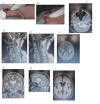A Rare Case of Nasal myiasis following Kidney Transplantation
- PMID: 39736952
- PMCID: PMC11682508
- DOI: 10.32592/ARI.2024.79.3.675
A Rare Case of Nasal myiasis following Kidney Transplantation
Abstract
In this case report, we present a 63-year-old man with a history of diabetes mellitus and kidney transplantation who was diagnosed with nasal myiasis. The patient presented with symptoms of nasal myiasis infestation, including epistaxis, nasal obstruction, nasal discharge, and the presence of larvae. The patient had risk factors for poor wound healing, such as hyperglycemia, and the presence of diabetes mellitus, hypertension, and kidney transplantation indicated the presence of predisposing factors for myiasis. The myiasis was observed subsequent to the traumatic insertion of a nasogastric tube. The patient exhibit[ed symptoms of myiasis infestation in the nasal region, including epistaxis, nasal obstruction, and nasal discharge, along with the presence of larvae. Our findings highlight the occurrence of nasal myiasis in a patient with a complex medical history, and emphasize the need for clinicians to remain vigilant for this infection. Axial CT scan showed no mucosal thickening, and T1 weighted cervical MRI showed no abnormal signal intensity, except for spondylopathy and modic changes. Diffusion Weighted-MRI (DWI) revealed no abnormal signal in the brain parenchyma. Our findings suggest the importance of clinicians being vigilant for nasal myiasis in patients with predisposing risk factors, such as diabetes mellitus and kidney transplantation. Managing nasal myiasis can be challenging, particularly in patients with multiple conditions. The management of nasal myiasis can be challenging, particularly in patients with multiple comorbidities.
Keywords: Clinicians; Management; Myiasis; Nasal.
Conflict of interest statement
The authors declare no competing interests. Availability of data and materials All available data have been shared in the manuscript.
Figures

Similar articles
-
Nasal myiasis by fruit fly larvae: a case report.Eur Arch Otorhinolaryngol. 2006 Dec;263(12):1142-3. doi: 10.1007/s00405-006-0112-0. Epub 2006 Jul 11. Eur Arch Otorhinolaryngol. 2006. PMID: 16832625
-
[Nasal myiasis].Ugeskr Laeger. 1995 Apr 10;157(15):2158-60. Ugeskr Laeger. 1995. PMID: 7652956 Danish.
-
Nasal and ophthalmomyiasis: case report.J Laryngol Otol. 2010 Aug;124(8):934-5. doi: 10.1017/S0022215109992714. Epub 2010 Jan 13. J Laryngol Otol. 2010. PMID: 20067649
-
Nasal Myiasis in Hinduism and Contemporary Otorhinolaryngology.J Relig Health. 2017 Aug;56(4):1263-1281. doi: 10.1007/s10943-013-9817-8. J Relig Health. 2017. PMID: 24385004 Review.
-
Nasal myiasis in patients with disturbance of consciousness: A case report and literature review.Zhong Nan Da Xue Xue Bao Yi Xue Ban. 2021 Dec 28;46(12):1442-1446. doi: 10.11817/j.issn.1672-7347.2021.210152. Zhong Nan Da Xue Xue Bao Yi Xue Ban. 2021. PMID: 35232917 Free PMC article. Review. Chinese, English.
References
-
- El-Badry AA, Salem HK, El-Aziz Edmardash YA. Human urinary myiasis due to larvae of Clogmia (Telmatoscopus) albipunctata Williston (Diptera: Psychodidae) first report in Egypt. J Vector Borne Dis. 2014;51(3):247–9. - PubMed
-
- Babamahmoudi F, Rafinejhad J, Enayati A. Nasal myiasis due to Lucilia sericata (Meigen, 1826) from Iran: a case report. Trop Biomed. 2012;29(1):175–9. - PubMed
-
- Bosmia AN, Zimmermann TM, Griessenauer CJ, Shane Tubbs R, Rosenthal EL. Nasal Myiasis in Hinduism and Contemporary Otorhinolaryngology. J Relig Health. 2017;56(4):1263–1281. - PubMed
Publication types
MeSH terms
LinkOut - more resources
Full Text Sources
Medical
